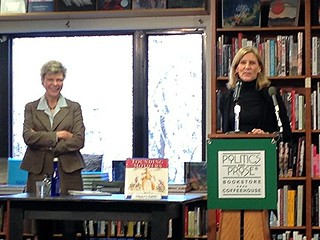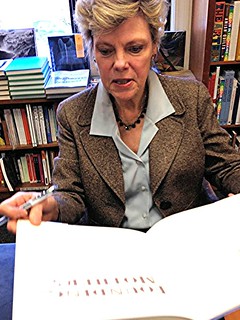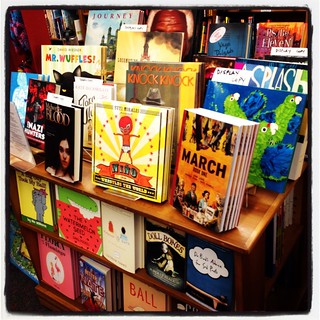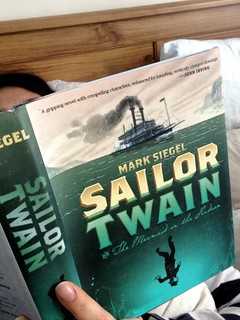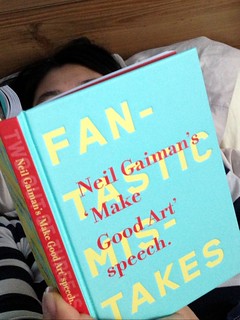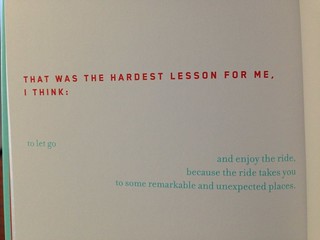[Note: I read an ARC of this book post-publication. I don't have an official copy so all of my comments are based on the ARC.]
Martin W. Sandler's
Imprisoned: The Betrayal of Japanese Americans During World War II is a great overview of the history of the Japanese American internment during World War II. The text is appropriate for middle school students, but the book would also work for older students (and adults) who haven't been exposed to this part of US history.
There was a quote in the book from a former internee who wondered if, during the war, people on the East Coast were even aware of the internment of Japanese Americans. I wonder if that still holds true today. Having lived in the Los Angeles area for most of my life, the Japanese American community and the history of internment were a constant in my life. I'm not sure that's necessarily the case on the East Coast (or the Midwest), where the Japanese American population is considerably smaller. For those who have had minimal exposure to Japanese Americans,
Imprisoned would be a good primer.
Chapter 1: The Japanese Come to America
Chapter 2: Hysteria
Chapter 3: Removal
Chapter 4: Temporary Prisons
Chapter 5: The Removal Centers
Chapter 6: Japanese Americans at War
Chapter 7: Undercover Warriors
Chapter 8: Redress
Chapter 9: Never Again
The book covers the beginnings of the Japanese American (JA) community on the West Coast, the racism they encountered in the early 1900s, the subsequent treatment and detainment/imprisonment of the entire West Coast JA community (minus the Hawaiian Japanese Americans) after the bombing of Pearl Harbor, the military service of young JAs, how the community dealt with re-assimilating into "regular" life after the war, and the redress movement. The book provides a nice arc of the JA experience with the added benefit of interviews and photos from those who were sent to camps.
From the publisher's summary:
While Americans fought for freedom and democracy abroad, fear and
suspicion towards Japanese Americans swept the country after Japan's
sneak attack on Pearl Harbor. Culling information from extensive,
previously unpublished interviews and oral histories with Japanese
American survivors of internment camps, Martin W. Sandler gives an
in-depth account of their lives before, during their imprisonment, and
after their release. Bringing readers inside life in the internment
camps and explaining how a country that is built on the ideals of
freedom for all could have such a dark mark on its history, this
in-depth look at a troubling period of American history sheds light on
the prejudices in today's world and provides the historical context we
need to prevent similar abuses of power.
I really appreciated that Sandler included information about the
Quakers (the American Friends Service Committee), who were vocal and active in objecting to the internment. It's important to recognize that, despite the majority of Americans who favored the imprisonment of Japanese Americans, there were those who were horrified that this was happening in the "Land of the Free," and it was their duty as citizens to point out that this was morally wrong, unjustified, and illegal. The Quakers continued with this work after 9/11 when Muslim Americans (and anyone who looked Arab) were being subjected to similar treatment as Japanese Americans 60 years prior.
I'm not an expert on the Japanese American internment, but I have personal connections to it. Members of my dad's family were interned at the
Gila River (Arizona) camp during the war, but I didn't know the details about their experiences. My grandparents never talked about it, and it was probably with great reluctance that they even discussed it with me during high school. What I do distinctly remember, though, is my grandfather's pride of being an American. After they were released from Gila, they reluctantly moved to Japan (where my dad was born) because of how difficult it was to start over in Los Angeles (my grandpa was a pharmacist with a degree from USC). But it was always my grandfather's wish to return to the United States despite what had happened to their family during the war. They moved back to Los Angeles when my dad was in high school. The only indication of their internment was the apology/redress letter from President George Bush in their living room. (Now that I think about it, I wonder where that letter went after my grandparents passed away ...)
My issues with the content of the book come from my personal knowledge and what I feel could've been included. Don't get me wrong; what's included is a solid introduction to the internment and includes information I didn't know. (For example, did you know the Canadian government expelled their Japanese Canadian citizens to internment camps a month before Executive Order 9066 was signed by President Roosevelt?)
The exclusion of the
Heart Mountain Fair Play Committee (Heart Mountain Resisters) is huge, in my opinion. With the word "betrayal" in the subtitle, Sanders had an opportunity to show that within the JA community the betrayal they felt by the US government manifested itself very differently. My guess is that very few people know about the group of young JA men who
resisted the draft on the grounds that their Constitutional rights as
Americans were being violated, and the illegality of their incarceration
had to be resolved before they would comply with a draft order. It's a far cry from the majority of young JAs who willingly and bravely fought in the war to prove their loyalty to the United States. In fact, the Heart Mountain Resisters were persecuted by most of the Japanese American community and were ostracized for many years following the end of the war. I feel the Resisters showed a different form of bravery by standing on the principle that they had rights as United States citizens, knowing full well that their position wasn't popular among their own community.
One of the leaders of the movement,
Frank Emi,
was a student of mine when I taught computer classes at a JA nonprofit
in Los Angeles's Little Tokyo. I never would've known about the Heart
Mountain FPC if not for Frank. He was an extremely dignified man, and so kind and polite. You could tell he was disciplined (he was a lifelong practitioner of judo) and, I have to admit, he was one of my favorite students. Frank passed away in 2010, but through his involvement with the Heart Mountain FPC he left a legacy of civil rights activism.
[Back in 1999 I worked at the Little Tokyo Service Center in Downtown Los Angeles as their computer lab director. Frank Emi was one of my students; he's in the blue shirt on the left.]
The internment camp photographs of
Ansel Adams and
Dorothea Lange are mentioned on several occasions in the book. Although Lange and Adams had differing views on what their photographs should convey, both were essentially outsiders to the experience.
Toyo Miyatake was an internee and a professional photographer who took photographs of the everyday camp experiences of the JA community. (He smuggled a camera lens into Manzanar and built a camera from wood scraps!) Again, I feel that Sandler had a prime opportunity to showcase a lesser known, but equally important, figure.
[Toyo Miyatake, JA photographer interned at Manzanar (photo from
"Toyo's Camera" movie website)]
Design-wise, I had a really hard time with one thing. The sidebar-like sections in a bigger font, which are often quotes repeated within the text, were actually part of the text or a completely independent fact/quote from the main text. The example below shows that the bolded text is a continuation of the first two lines on the page. This is easy to figure out, but there were sections that were not so obvious. I should've taken a picture of one of the poorly designed sections ... if I can find a copy of the book at the library or bookstore I'll add a picture to this post.
All in all, though, this is a book I can recommend to young people. As I said before, it's a good starting point for understanding this dark period and it provides an opportunity for them to ask questions.
Why would something like this happen? Could it happen again? Are there parallels to events that have happened in this century? We need the next generation to think critically about what it means to be an American, especially in an era when the demographics of the country continue to change drastically.
I found these quotes in the book to be particularly heartbreaking:
Perhaps most poignant of all was the statement made by a six-year-old. "Mommy," he exclaimed, "Let's go back to America."
Gazing at the soldiers in the guard towers, one child asked, "Mommy, who are they afraid of?"
We cannot allow any American child (regardless of race, color, national origin, religion, creed, sexual orientation, etc.) to grow up repeating these kinds of words. Students -- and adults who teach young people -- need to continue to educate themselves about parts of our history that may not be well-covered in text books. It is truly for the well-being of our nation and its future.
Imprisoned would be a good addition to any school or classroom library collection.
Imprisoned: The Betrayal of Japanese Americans During World War II (2013)
by Martin W. Sandler
Walker Childrens (Bloomsbury); 176 pages
Other Resources:
[Updated February 2, 2014 :: My husband forwarded me this article, "
Growing Up Japanese American in Crenshaw and Leimert Park," which is a fascinating look at the
sansei (third generation JA) growing up in Los Angeles after WWII. It is a dramatically different world and attitude about race & culture from what's described in
Imprisoned. It's worth a read if you're interested to see how parts of the JA community changed after internment.]

